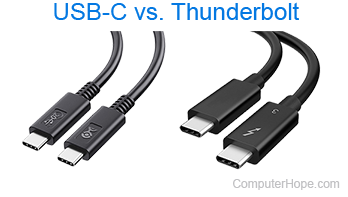What are the differences between USB-C and Thunderbolt?

In today's electronic world, there are many types of cables, connectors, and ports. If you follow sources related to laptops and mobile devices, you've probably heard comparisons made concerning two technologies in particular: USB and Thunderbolt. Parallels are rightfully drawn as they have a lot in common. But, there are also differences.
Whether you're curious or looking for help making a decision about your next electronics purchase, the following sections should help you out.
What are USB and Thunderbolt?
To begin with, let's learn a bit about these technologies and understand why they exist in the first place.
USB (Universal Serial Bus) has been around for about 30 years. It was created to transfer data and facilitate communication between devices (usually peripherals) and computers while utilizing a single interface type – hence the "universal" part of the name. USB also delivers power to devices for charging or other features like LEDs (light-emitting diodes).
Developed by Intel and Apple and produced since 2011, Thunderbolt's functions and uses are nearly identical to USB. However, even in its first iteration, it could transfer video data with its built-in DisplayPort technology (it even used Mini DisplayPort as a connector in versions 1 and 2). This, along with the ability to daisy chain peripheral devices, were Thunderbolt's main selling points. Also, the original version supplied 10 watts of power to connected devices instead of the 4.5 watts provided by USB 3.0 at the time.
A key similarity is that both of the latest iterations of these technologies (USB4 and Thunderbolt 4) utilize the USB Type-C reversible 24-pin connector. The differences in functionality and performance come down to the version and specifications of said cabling.
USB and Thunderbolt comparison table
The table below is a visual representation of the general features of both USB and Thunderbolt.
| Feature | USB4 | Thunderbolt 4 |
|---|---|---|
| Availability | Most new desktops, laptops, and nearly all smartphones. | All Apple computers and many Windows laptops. |
| Cost | Generally less expensive to produce. | Older, active cables (versions 1 and 2) were more expensive to produce, especially at longer lengths. |
| Transfer speeds | Up to 80 Gbps, but starts as low as 20 Gbps for USB4 version 1. | Up to 40 Gbps, but no lower than 32 Gbps for Thunderbolt 3. |
| Compatibility | Fully backward compatible with an adapter. Also works with Thunderbolt 3 and 4. | Thunderbolt 3 and 4 work with one another; manufacturer-based compatibility with "general" USB-C devices. |
| Display Support | Multiple 8K displays or one 16K display. | Up to two 4K displays or one 8K display. |
| Power delivery | Up to 100 watts. | Up to 100 watts. |
Conclusions
This comparison is a misnomer for one reason: USB-C is a connector type, and Thunderbolt is a hardware interface technology. What we should be contrasting are the specifications of the technology versions, as we did in the table above.
As far as functionality is concerned, users might refer to the old adage, "All squares are rectangles, but not all rectangles are not squares." Essentially, both "port types" accept USB-C connectors, but power delivery and throughput are limited by the less capable technology version. For example, a USB 3.1 cable can't fully utilize a Thunderbolt 4 port's max transfer speed; the same would be true for a Thunderbolt 3 cable plugged into a USB4 2.0 port.
At times, Thunderbolt has seen advantages in both functionality (transmitting video signals) and throughput (data transfer speeds and power delivery) compared to USB. However, as of May 2024, most of those gaps were closed or surpassed. Furthermore, USB is more widely used and accepted.
Most consumers are satisfied with either selection as USB4 and Thunderbolt 4 are comparable in their capabilities and use the same USB Type-C connector.
